🎲 Classification
Learn about taxonomy and classification of nematodes based on feeding habit
Which of the following is incorrect regarding phylum nematode?
Taxonomy
- Nematodes are placed in Kingdom
Animaliaunder a separate phylum,Nematoda,

- The phyllum Nematoda is further classified into two classes, Secernentea and Adenophorea.
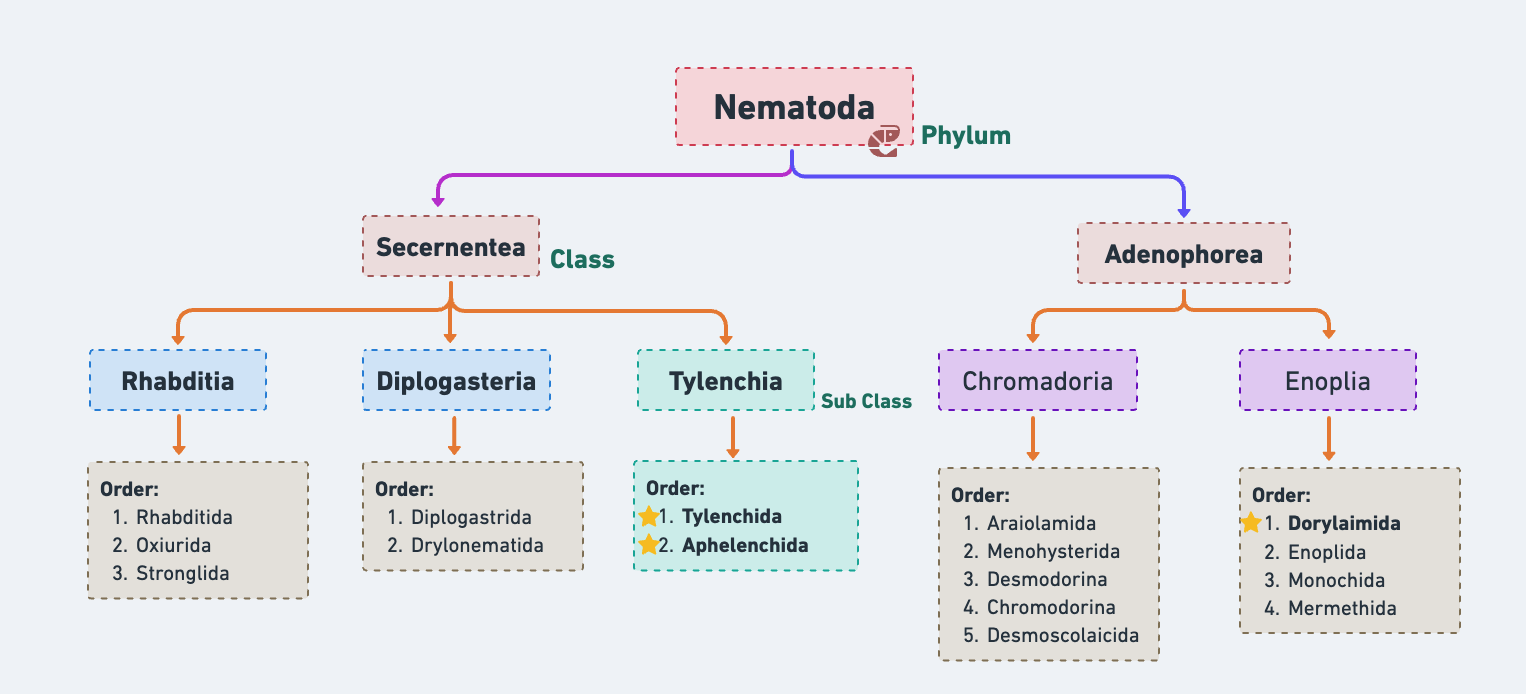
Diagnostic Characters of Class Secernentea and Adenophora
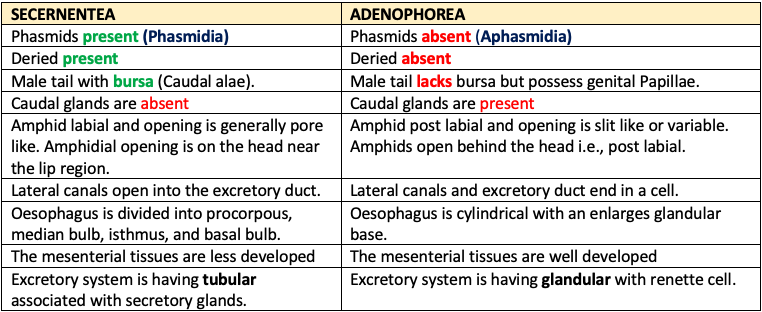
👉🏻 Order Tylenchida and Aphelenchida of Class Secernentea and Order Dorylamida of class Adenophorea are the two orders to which Plant Parasitic Nematode (PPN) belongs. Most of the important parasitic genera belong to the order Tylenchida, but a few belong to the order Dorylaimida & Aphelenchida.
Class: Secernentia
- Known as Phasmida because phasmid is present.
- Caudal glands are absent.
Order: Tylenchida
- Order Tylenchida is highly evolved and sedentary parasite in nature.
- It includes sub-order
Tylenchina. - Sub Order: Tylenchina is having Families:
- Tylenchoidea: E.g., Tylenchulus (Citrus Nematode)
- Anguinidae: E.g., Anguina (Wheat Seed-Gall Nematode), Ditylenchus (Stem and Bulb Nematode)
- Tylenchidae: Tylenchorhynchus (Stunt Nematode), Belonomus (Sting Nematode)
- Sub Order:
Haplolaimoideais having Families:- Pratylenchidae E.g., Pratylenchus, Radopholus, Nacobbus
- Hoplolaimidae E.g., Haplolaimus (Lance Nematode), Rotylenchulus (Reniform Nematode), Heliocotylenchus (Spiral Nematode), Scutellonema (Dry Rot Nematode)
- Sub Order:
Heterodoideais having Families:- Heteroderodae E.g., Heterodera (Cyst Nematode), Globodera (Golden Cyst Nematode)
- Meloidogynidae E.g., Meloidogyne (Root-Knot Nematode)
Order: Aphelenchida
- Sub Order: Aphelenchina contains Family: Aphelenchoididae
- Aphelenchoides (Foliar Nematode)
- Bursaphelenchus (Pine wilt)
Class: Adenophorea
- Known as Aphasmida because phasmids are absent.
- Caudal glands are present.
Order: Dorylaimida
- Super Family:
Logidoroidea- Family: Logidoridae
- E.g., Longidorus (Needle nematode), Paralongidorus
- Xiphinematidea (E.g. Xiphinema (Dagger Nematode))
- Family: Logidoridae
- Super Family:
Trichodoroidae- Family: Trichodoridae
- Trichodorus
- Paratrichodorus (Stubby-Root Nematode)

- Family: Trichodoridae
Classification
- Plant Parasitic Nematodes (PPN) bear stylet or spear, which is used like a hypodermic needle to puncture the host cell wall.
- Many plant nematodes inject enzymes into the host cell before feeding. These enzymes partially digest the cell contents before they are sucked into the gut.
- Most of the injury that nematodes cause to plants is related to the feeding process or feeding habits.
- Majority (90%) of PPNs
attack rootsor otherbelow ground plant partssuch as tubers, rhizomes, suckers, bulbs etc - Based on different feeding habits the plant parasitic nematodes are broadly categorized into two groups:
- Facultative Plant Parasites
- Obligate Plant Parasites
- According to feeding habits, the nematodes can be divide into:
I. Above Ground Feeders
- These nematodes feed on the above ground plant parts of the plant either stem, inflorescence, bud or seed. They crawl upon the plant with the help of thin film of moisture. They complete their life cycle on the above ground plant parts.
- These are mosty
Facultative Plant Parasites. - These act as both ecto and endo parasites.
- Feeding on flower buds, leaves and bulbs.
- Seed gall nematode: Anguina tritici
- Leaf and bud neamtode: Aphelenchoides
- Stem and bulb nematode: Ditylenchus
- Feeding on tree trunk
- Red ring nematode: Rhadinaphelenchus cocphilus
- Pine wilt nematode: Bursaphelenchus xylophilus
II. Below Ground Feeders
- Nematodes suck the sap of the plants with the help of stylet and causes leaf discolouration, stunted growth, reduced leaf size and fruits and lesions on roots, galls, reduced root system and finally wilting.
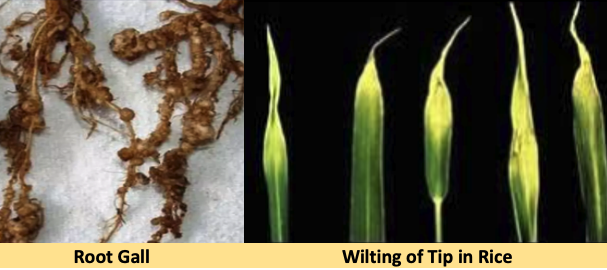
- Plant parasitic nematodes are stylet bearing nematodes which feed, establish and reproduce on the lower and higher group of plants.
- These are obligate Plant Parasites because these nematodes subsist entirely on host plant for deriving nutrition.
- Based on their feeding habits and site of feeding plant parasitic nematodes are further classified as follows:
- Ectoparasitic Nematodes
- Semi-endoparasitic Nematodes
- Endoparasitic Nematodes
1. Ectoparasite
- These groups of plant parasitic nematodes feed on the surface of the host plant on epidermal cells or semipermanently feed on cortical parenchymatous cells but their body remain exposed to soil.
- These nematode live freely in the soil and move closely or on the root surface, feed intermittently on the epidermis and root hairs near the root tip.
- Migratory Ectoparasitic nematodes:
- These nematodes feed superficially on the epidermal layer of the host plant migrating to different sites on the surface of the root.
- They complete their life cycle on soil.
- These nematodes spend their entire life cycle free in the soil.
- When the roots are disturbed, they detach themselves.
- E.g., Xiphinema, Longidorus, Paratylenchus spp., Dolichodorus heterocephalus.
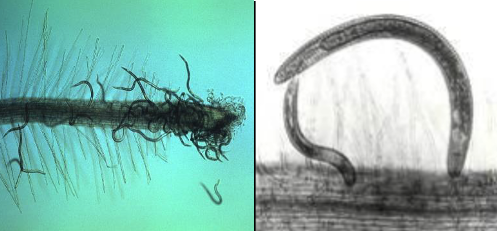
- Sedentary Ectoparasitic nematodes:
- These groups of nematodes differ from the migratory ectoparasitic.
- These nematodes have long stylet deeply buried into the cell but their body remains hanging on the soil.
- They complete their life cycle on soil.
- In this type of parasitism the attachment of nematode to the root system is permanent.
- E.g., Hemicycliphora arenaria and Cacopaurus pestis etc.,
2. Semi-Endoparasitic Nematodes
- These nematodes either feed on the vascular bundles or cortical feeders.
- One third of their body remain confined within the root while rest of the body remain hanging on the soil for which they are called semiendo parasitic nematodes.
- These nematodes complete their life cycle in the soil.
- Sedentary: E.g., Rotylenchulus renifomis and Tylenchulus semipenetrans.
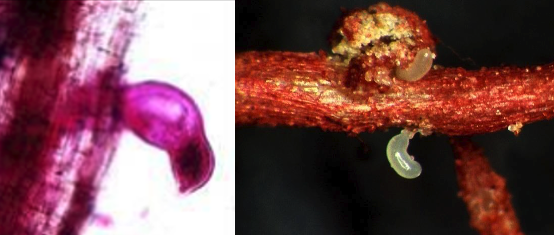
Tylenchulus semipenetrans
- Migratory: E.g., Haplolaimus, Tylenchorhynchus.
3. Endoparasites
- These group of nematodes entirely remain confined within the root, feed, establish and reproduce inside the root.
- The entire nematode is found inside the root and the major portion of nematode body found inside the plant tissue.
- Migratory Endoparasitic nematodes:
- These groups of nematodes feed inside the cortical parenchymatous cells while feeding they move ahead parallel to the longitudinal axis of the root creating cavities/ tunnels/ burrows inside which they lay their eggs and carry on their subsequent stage of life cycle.
- These nematodes move in the cortial parenchyma of host root. While migrating they feed on cells, multiply and cause necrotic lesions.
- Eg., Pratylenchus coffeae, and Radopholus similis etc.,
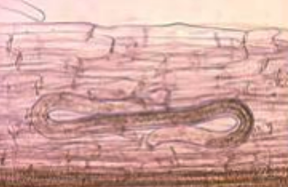
Pratylenchus sp.
- Sedentary Endoparasitic nematodes:
- These groups of nematodes are essentially vascular bundle feeders.
- These nematodes at their 2nd stage juveniles enter into the root and proceed either inter or intracellularly and fix their head on vascular bundles and rest portion of the body remain inside the root.
- They remain attached to a particular site of feeding permanently for which they are called sedentary.
- They complete their life cycle in the root.
- Eg., Meloidogyne incognita, Heterodera cajani, Globodera rostochiensis
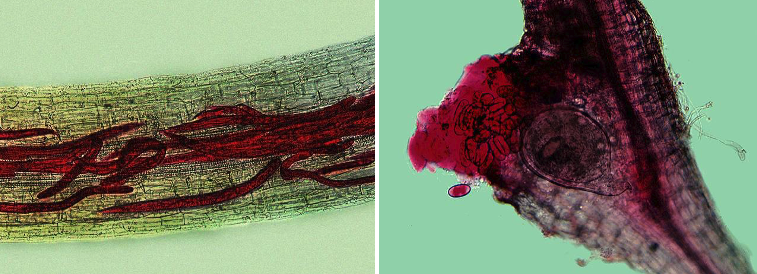
Meloidogyne sp.
References
- https://www.academia.edu/37734248/Lecturer_01_Introduction_History_and_Taxonomy_of_Plant_Parasitic_Nematodes
- Upadhyay, K.D. and Dwivedi, K. Textbook of Plant Nematology. Amam Publishing House, Merrut.
- Walia, R. K and Bajaj, H. K (2014). Textbook of Introductory Plant Nematology. Directorate of Knowledge Management in Agriculture, ICAR, New Delhi.
- Ravichandra, N. G. (2019). Plant Nematology. I. K. International Publishing House Pvt. Ltd., New Delhi.
- Dasgupta, M. K. (1998). Phytonematology. Pilgrims Publishing.
Which of the following is incorrect regarding phylum nematode?
Taxonomy
- Nematodes are placed in Kingdom
Animaliaunder a separate phylum,Nematoda,

- The phyllum Nematoda is further classified into two classes, Secernentea and Adenophorea.

Diagnostic Characters of Class Secernentea and Adenophora

👉🏻 Order Tylenchida and Aphelenchida of Class Secernentea and Order Dorylamida of class Adenophorea are the two orders to which Plant Parasitic Nematode (PPN) belongs. Most of the important parasitic genera belong to the order Tylenchida, but a few belong to the order Dorylaimida & Aphelenchida.
Class: Secernentia
- Known as Phasmida because phasmid is present.
- Caudal glands are absent.
Order: Tylenchida
- Order Tylenchida is highly evolved and sedentary parasite in nature.
- It …
Become Successful With AgriDots
Learn the essential skills for getting a seat in the Exam with
🦄 You are a pro member!
Only use this page if purchasing a gift or enterprise account
Plan
- Unlimited access to PRO courses
- Quizzes with hand-picked meme prizes
- Invite to private Discord chat
- Free Sticker emailed
Lifetime
- All PRO-tier benefits
- Single payment, lifetime access
- 4,200 bonus xp points
- Next Level
T-shirt shipped worldwide

Yo! You just found a 20% discount using 👉 EASTEREGG

High-quality fitted cotton shirt produced by Next Level Apparel